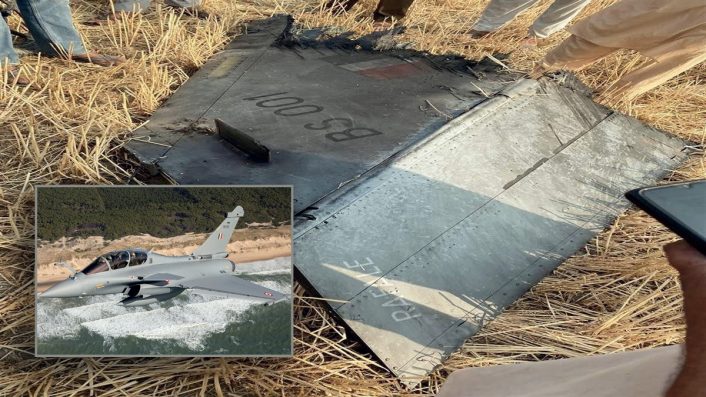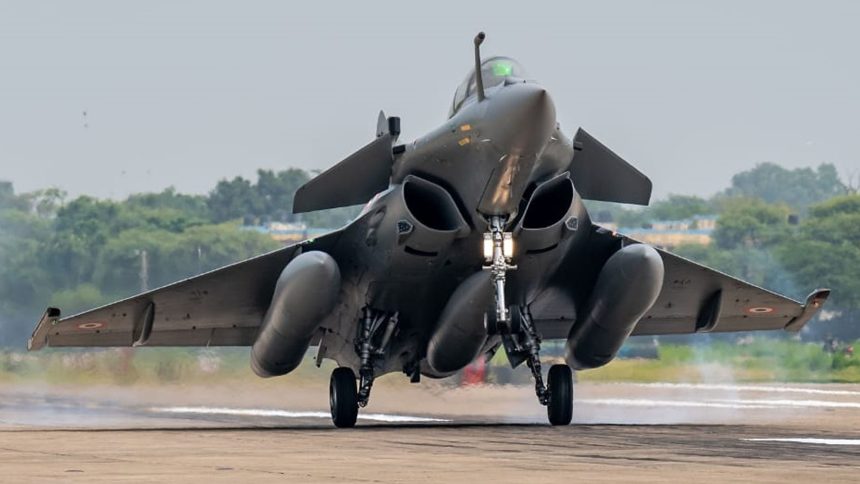Kill chain and long-range missile gave Pakistan the edge in Rafale shootdown, according to a recent report by Reuters.
On Aug. 2, 2025, an interesting story by Reuter’s Saeed Shah and Shivam Patel laid out how a Pakistan Air Force J-10C downed at least one Indian Air Force Rafale using a PL-15 air-to-air missile fired from roughly 200 km, a kill envelope Indian planners did not expect the PAF to achieve that night.
The Reuters reconstruction of the May 7, 2025 air battle over (and just inside) Pakistan reads like a checklist of modern air warfare: BVR (Beyond-Visual-Range) shots, multi-domain sensor fusion, electronic attack, and, crucially, information superiority (or lack thereof) along with various assumptions about the enemy’s weapons that turned out to be wrong.
While very few details have been officially confirmed thus far, imagery and analysis point to at least one Rafale loss, allegedly the first combat loss for the type. In the aftermath of the aerial engagements, Indian officials declined comment; social media lit up with counter-claims and disinformation; and only fragments of physical evidence (a MICA still on its pylon, engine debris) emerged from inside India. The Reuters piece adds names, timing, and the operational plumbing behind what we saw in the fog of war.

Two lines in the Reuters story jump out. First, that Pakistan’s Air Chief reportedly told his team, “He wanted Rafales.” Second, that the decisive factor wasn’t platform A versus platform B, but information: as retired RAF Air Marshal Greg Bagwell put it, “The winner in this was the side that had the best situational awareness.” Those details fit the observable pattern of the night: both sides largely stayed within national airspace, fought at range, and relied on their airborne and ground sensors to build a picture faster than the other guy.
We have often highlighted how crucial in modern warfare is to achieve the so-called “Information Superiority” (i.e. the operational advantage derived from the ability to collect, process, and disseminate an uninterrupted flow of information while exploiting or denying an adversary’s ability to do the same).
Spoke to #PakistanAirForce Chief ACM Zaheer Ahmed Baber yesterday. The PAF brought down the IAF’s entire kill chain on May 5-10. Satellite downlinks were scuttled, radars jammed and GPS killed. IAF was fortunate not to lose more than four , yes four, Rafales.
— Alan Warnes (@warnesyworld) July 9, 2025
In the aerial engagement between India and Pakistan, what actually tipped the scales was, according to Reuters, an Indian intelligence miss on the effective range of the PL-15. Indian aircrews believed they were outside engagement distance, roughly 150 km, a figure associated with an export-limited variant, However, they were not. If the J-10C launched from ~200 km as Pakistani officials contend (and possibly farther, according to Indian officials interviewed), the shot falls into the longest documented BVR kills to date. We should caveat that range is a function of geometry and kinematics, not a static number, as altitude, speed, target aspect, and guidance support matter, but it underscores the point: if you mis-read the envelope, you’ll fly the wrong game plan.
Official kill mark of an Indian Rafale jet on the side of a Pakistani J-10C. pic.twitter.com/zYs40vqyYh
— Clash Report (@clashreport) May 18, 2025
The second pillar is networking. According to Pakistani officials, the PAF fused feeds across air, land and space – what they describe as a homegrown “Data Link 17” backbone – to pass radar tracks from a standoff surveillance platform to forward J-10Cs, letting the shooters run quiet and still prosecute long-range shots. India, with a more diverse fleet from multiple suppliers, is still knitting together a comparable kill chain.
Beware, none of this proves Chinese “hardware” is universally superior to Western one; it does show how a coherent network, fielded and rehearsed, can erase a platform or a numbers gap.
It’s also consistent with the pattern we tracked in the days after May 7. Reuters previously reported that J-10Cs downed at least two Indian aircraft; Delhi has not publicly acknowledged the Rafale loss, but senior French officials later indicated they had seen evidence of the shoot-down. Meanwhile, India adapted quickly, shifted tactics, and used BrahMos strikes against Pakistani military infrastructure before a ceasefire took hold: on May 10, India claimed it struck at least nine air bases and radar sites in Pakistan; it also hit a surveillance plane parked in a hangar in southern Pakistan.
A ceasefire was agreed later that day, after U.S. officials held talks with both sides.
For many military aviation watchers, the aerial engagement was the chance to to turn it into a referendum on the Rafale, but it’s actually something else, a well-flown, well-supported 4.5-gen fighter can still be surprised if the opposing side brings a longer reach, better timing, and a cleaner network on a given night. The Rafale’s kinematics, sensors, and Spectra suite remain formidable; what failed, per Reuters’ sources, was the assumption set. India appears to be updating both equipment (notably on the Su-30MKI) and TTPs accordingly. Therefore, it’s safe to assume a future BVR air battle may have a different outcome.
Dassault Denies CEO Commented on Rafale Losses by India
Dassault Aviation denied that CEO Éric Trappier made any comments about Rafale fighter jet losses during India’s Operation Sindoor, contradicting media reports quoting him.
Indian media earlier claimed Trappier said India… pic.twitter.com/PwWfZVEqAa
— Clash Report (@clashreport) July 9, 2025
Interestingly, in the days following the engagement, India’s deputy army chief, Lt. Gen. Rahul Singh, suggested that Pakistan may have received “live inputs” from China during the air battles, hinting at the possible sharing of real-time radar and satellite data. However, he did not present any evidence to support the claim, and Islamabad firmly denied the accusation.
Questioned about military cooperation with Pakistan during a press briefing in July, Chinese Foreign Ministry spokesperson Mao Ning described the collaboration as part of the “normal cooperation between the two countries” and stated that it was not directed against any third party.
Meanwhile, Beijing’s air chief, Lt. Gen. Wang Gang, visited Pakistan in July to reportedly discuss how Chinese systems were used to establish the “kill chain” that led to the Rafale shootdown, according to two Pakistani Air Force officials. When asked about the meeting, Chinese authorities did not comment, while Pakistan’s military later stated that Wang had shown a strong interest in PAF’s operational experience in Multi-Domain Operations.
Back on May 7, we urged caution as images and claims flooded the timeline. Some of those early photos did line up with a Rafale loss, and French reporting later added weight to that assessment. The new Reuters account doesn’t end the debate as Delhi still hasn’t confirmed (although some lawmakers have), but it provides the most complete open-source narrative yet of how the engagement unfolded and why.
India’s Kerala MP K Francis George:
India lost five fighter jets: 3 Rafales, 1 Sukhoi-30MKI, 1 MiG-29 in unacknowledged wartime incidents.
All shot down in our own territory.
He accused the government of hiding the losses, citing unnamed sources. pic.twitter.com/U30JeA8JUf
— Clash Report (@clashreport) July 29, 2025
If there’s a single lesson here for air forces everywhere, it’s this: know the real numbers, not the datasheet ones; practice the links, not just the launches; and assume your opponent is doing the same.
CDS Anil Chauhan has said that #OperationSindoor is still on.
This has been said to give escape route to the government to not discuss the air battle on May 7/8 night with the opposition in the Parliament.
Without this, rest is of little consequence because both sides have…
— Pravin Sawhney (@PravinSawhney) July 26, 2025









